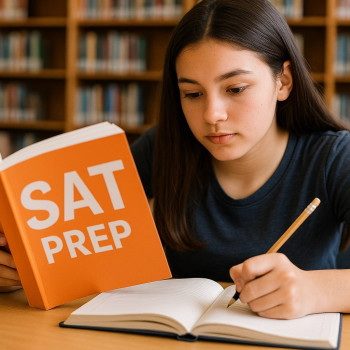When Test-Optional Means Tests Take a Back Seat
There’s a common misconception floating around high school hallways and kitchen table conversations: test-optional means the SAT doesn’t matter at all. That’s not quite right — but it’s closer to the truth at some colleges than at others. If you’re a student (or a parent guiding one) trying to prioritize time, energy, and resources, it helps to know where the SAT is truly optional in practice, which colleges weigh other parts of the application more heavily, and how to present the strongest possible application whether you submit scores or not.

What “Test-Optional” Actually Means — And What It Doesn’t
“Test-optional” is an admissions policy category that gives applicants the choice to submit SAT (or ACT) scores — or not. Importantly:
- It doesn’t mean colleges ignore test scores entirely. If you send strong scores, they may be considered.
- It doesn’t guarantee admission without scores; it simply removes the automatic requirement to submit one.
- Policies vary widely: some colleges are test-blind for certain applicant types; others are test-optional but still use scores for scholarships or course placement.
So, when we say a college is a place “where test-optional makes SAT less important,” we mean colleges whose holistic review systems genuinely prioritize grades, coursework, essays, recommendations, extracurriculars, and fit — and where not submitting a test doesn’t put an applicant at a formal disadvantage.
Which Colleges Usually Make the SAT Less Important?
Rather than a single list of names, think in categories. These categories help you decide where to focus time and resources.
1) Liberal arts colleges with truly holistic review
Many selective liberal arts colleges emphasize course rigor, grades, teacher recommendations, and personal qualities more than standardized test scores. For students with compelling essays, strong teacher endorsements, and distinctive extracurricular narratives (e.g., a meaningful community project, artistic portfolio, leadership in a club), an application can be competitive without test scores.
2) Public universities with test-optional systems for in-state applicants
Several public universities have test-optional policies specifically for in-state or first-year applicants. At these schools, academic record and class rank/playbook matter a great deal — especially for state-funded institutions that have access to high school transcripts across the state and can compare applicants using GPA and course rigor.
3) Schools that weigh demonstrated interest, portfolios, or auditions
Colleges with robust portfolio or audition pathways — art schools, music conservatories, some journalism or architecture programs — often treat test scores as supplementary. If your strengths are demonstrable in a portfolio or audition, that can outweigh a missing or modest SAT score.
4) Institutions that explicitly separate testing from scholarships
Some colleges are test-optional for admissions but still use scores to award merit scholarships. Others are the reverse. If scholarship reliance on SATs is low at a school, then the SAT will feel less important in the practical sense.
How Colleges Evaluate Applicants Without Scores
Admissions offices don’t simply toss out a blank field and hope for the best. They reweight. Here’s what typically carries more weight when SAT scores are absent:
- High school transcript: grades, course rigor, upward trends.
- Application essays: voice, clarity, evidence of reflection and intellectual curiosity.
- Letters of recommendation: context about persistence, character, and academic potential.
- Extracurricular depth and leadership: sustained commitment beats a laundry list of activities.
- Contextual factors: first-generation status, community challenges, family responsibilities.
Example: Two Applicants, Same School
Imagine a selective liberal arts college receiving two applications:
- Applicant A: 3.9 GPA, AP/IB coursework, a compelling personal essay about caregiving for a family member, two strong teacher recommendations, no SAT submitted.
- Applicant B: 4.0 GPA, fewer APs, shorter extracurricular list, submits a high SAT score but weaker essays and one lukewarm recommendation.
At a test-optional school that values context and narrative, Applicant A might be more attractive because the rest of the application offers rich evidence of character and academic readiness — even without an SAT score.
Practical Guide: When You Can Safely Skip the SAT
There’s no one-size-fits-all checklist, but this decision-making framework helps:
- If your score is well below the middle 50% at a college and the rest of your application is strong → consider not submitting.
- If your score is within or above the middle 50% → submitting can help, especially for competitive scholarships.
- If your strengths are demonstrated through a unique portfolio, audition, or exceptional non-academic achievements → SAT becomes less central.
- If you need SAT-based scholarships or to meet major-specific prerequisites (e.g., engineering placement) → consider taking the test.
Questions to Ask Before Deciding
- Does the college explicitly state that not submitting scores will not disadvantage applicants?
- Are merit scholarships tied to test scores at this institution?
- Does the college publish the role of SAT/ACT scores in its holistic review?
- Would a strong test score complement an otherwise weak part of your application (e.g., a GPA affected by early high-school struggles)?
Checklist: Strengthening a Test-Optional Application
If you’re considering applying without SAT scores, prioritize building evidence of academic and personal readiness in other parts of the file.
- Maximize transcript strength: take a thoughtful mix of honors, AP/IB, or dual-enrollment courses that match your intended major.
- Write essays that show reflection, growth, and specificity. Tell stories only you can tell.
- Secure meaningful recommendations from teachers who can speak to intellectual curiosity and resilience.
- Show depth in extracurriculars: long-term commitment, measurable impact, or leadership roles.
- Highlight context: explain any unusual circumstances in the optional additional info section.

Table: Quick Comparison — When SAT Matters vs. When It Doesn’t
| Scenario | Test-Optional Colleges: SAT Importance | Action Step |
|---|---|---|
| High GPA, strong coursework, standout essays | Low — SAT optional and unlikely to change outcome | Focus on essays, recommendations, and fit statements |
| Strong SAT but uneven GPA or weak course rigor | Moderate — submitting can help offset transcript concerns | Consider sending scores; explain transcript context |
| Applying for merit scholarships that list test scores as factor | High — may affect financial aid awards | Prepare for the SAT and submit your best score |
| Arts, performance, or portfolio-driven admissions | Low — auditions/portfolios often primary | Invest time in portfolio/audition prep and recording quality |
| Targeting highly selective universities that resumed testing policies | Variable — many top schools re-evaluated policies; some use tests again | Research each school; consider testing if within score ranges |
Real-World Context: Why Policies Shift (and Why That Matters to You)
Admissions policies evolve with time, leadership, and data. During the pandemic, many institutions moved quickly to test-optional to remove barriers. Over the last few application cycles, some colleges reinstated testing requirements while others kept or refined test-optional rules. What that means for applicants is practical: you must check each college’s current policy for the exact year you’re applying, because test policies, scholarship rules, and major-specific requirements can change from one admissions cycle to the next.
How to Research a School’s Current Policy (Practical Steps)
Do these four things before you decide to skip or submit test scores:
- Check the college’s admissions page for the current application cycle — read the test policy language carefully.
- Look at the “middle 50%” score ranges published by the college to see where your score would sit.
- Search the financial aid or scholarships page to confirm whether tests affect merit awards.
- Ask the admissions office a direct question by email or phone if anything in the wording is ambiguous.
Examples of Application Strategies by Student Type
Student 1: The High GPA, Low Test-Taker
Profile: 3.95 GPA, lots of honors/AP classes, strong essays, limited standardized testing history.
Strategy: Apply test-optional to liberal arts colleges that prioritize coursework and essays. Spend time polishing supplemental essays and collecting two or three strong teacher recommendations. If scholarships are a concern, selectively send a single SAT sitting if the score supports aid consideration; otherwise, redistribute prep time to extracurricular leadership and portfolio building.
Student 2: The Strong Tester With a Bumpy Transcript
Profile: 3.6 GPA with an upward trend (freshman-year struggles), SAT 1500.
Strategy: Send SAT scores to colleges where 1500 is within or above the mid-50%. Use the additional info section to explain early challenges and highlight subsequent improvements. Keep cultivating teacher recommendations that can attest to academic growth.
Student 3: The Artist or Performer
Profile: Portfolio of original work, national-level competitions, but SAT is middling.
Strategy: Focus on portfolio or audition excellence and make sure the application tells a cohesive story about practice, growth, and creative ambition. Apply test-optional and only send scores if needed for scholarships or placement.
How Families Should Allocate Resources (Time, Money, Energy)
With limited bandwidth, smart allocation matters:
- Prioritize authentic application materials: essays and recommendations often provide higher return on investment than additional SAT sittings beyond a reasonable retake plan.
- If scholarships depend on test scores at your target schools, budget for one or two quality test sittings rather than many rushed attempts.
- Invest in targeted help: a short, focused tutoring plan for an admissions essay or portfolio review can be more valuable than broad but shallow test prep.
How Personalized Tutoring Can Shift the Balance
Personalized guidance is especially powerful in a test-optional landscape. For many students, the difference between a good application and an outstanding one is not an extra week of practice, but a tailored strategy that plays to strengths and covers weaknesses.
Sparkl’s personalized tutoring offers 1-on-1 guidance, tailored study plans, expert tutors, and AI-driven insights that help students decide whether to test, how to present their story, and which parts of the application to strengthen. For example, a Sparkl tutor can help you:
- Assess whether your SAT score strengthens or weakens your application.
- Create a study plan that targets improvements efficiently (focusing on the few points that change admit chances most).
- Polish essays with iterative, individualized feedback so your voice shines through.
- Prepare portfolios or supplemental materials that demonstrate sustained growth and impact.
A Real Case Study (Composite, But Typical)
Maria, a high school senior from a mid-sized town, had a 3.9 GPA, prose-writing awards, and leadership in a community tutoring program. Her first SAT was 1180 — not reflective of her classroom performance. Maria decided not to submit that score and instead worked with a Sparkl tutor to:
- Revise her personal statement to highlight her tutoring program’s measurable impact (number of students helped, documented improvement, and a personal story that explains her motivation).
- Refine teacher recommendation requests so they reflected her academic resilience and leadership.
- Strategically choose test-optional colleges that valued community engagement and essays.
She ultimately applied without SAT scores to several liberal arts colleges and submitted one improved test score to a selective public university where it helped with scholarship consideration. The result: multiple acceptances and an offer that matched both her academic interests and financial needs.
Common Missteps to Avoid
- Assuming all test-optional policies are identical — read the exact wording for each college and each application cycle.
- Using test-optional as an excuse to under-prepare your application essays or recommendations.
- Over-focusing on retaking the SAT without a plan — improvements are not guaranteed and diminishing returns can set in.
- Ignoring scholarship rules — test-optional admissions and test requirements for scholarships are separate considerations.
Timeline: What To Do in the Year Before Applications
- Months 12–9 before applications: Research each target school’s current testing and scholarship policies. Build your college list and identify application types (ED, EA, RD) and deadlines.
- Months 9–6: Take the SAT once if you plan to test. Begin essay drafts and request teacher recommendations early.
- Months 6–3: Review score results and decide whether to submit. If retesting, do a targeted, brief prep cycle. Finalize essays and polish supplemental materials.
- Months 3–0: Complete applications, add optional context where needed, and verify financial aid/scholarship requirements.
Final Thoughts: Test-Optional Is Opportunity, Not Confusion
Test-optional policies give applicants more ways to show who they are. For many students and families, this can reduce stress and open doors to colleges that value diverse kinds of excellence. But it also requires strategic thinking. The SAT can still be an asset — or an unnecessary extra — depending on your profile and the schools you target.
Take stock of your strengths: if you shine in classroom work, community leadership, or a creative field, make those parts of your application irresistible. If standardized testing is a strength, use it deliberately — particularly for scholarship consideration. And if you’re unsure which route to take, a tailored plan from an experienced coach can clarify the trade-offs and maximize your odds.
One Last Tip for Parents and Students
Admissions is a story-telling process. The test score — if present — is a data point. The transcript, the letters, the essays, the portfolio, and the narrative you craft together are the story. Make that story coherent, honest, and unmistakably yours.
Want Personalized Help?
If you’re feeling unsure about whether to test or how to strengthen a test-optional application, consider getting individualized support. With 1-on-1 guidance, tailored study plans, and AI-driven insights, Sparkl’s tutoring can help you prioritize what matters most — improving essays, building a portfolio, or targeted test prep — so your application represents the best version of you.
Whether you submit SAT scores or not, the goal is the same: present a clear, authentic, and compelling case for why a college should choose you. Test-optional is not an escape hatch; it’s a chance to let your strengths lead the way.

















No Comments
Leave a comment Cancel